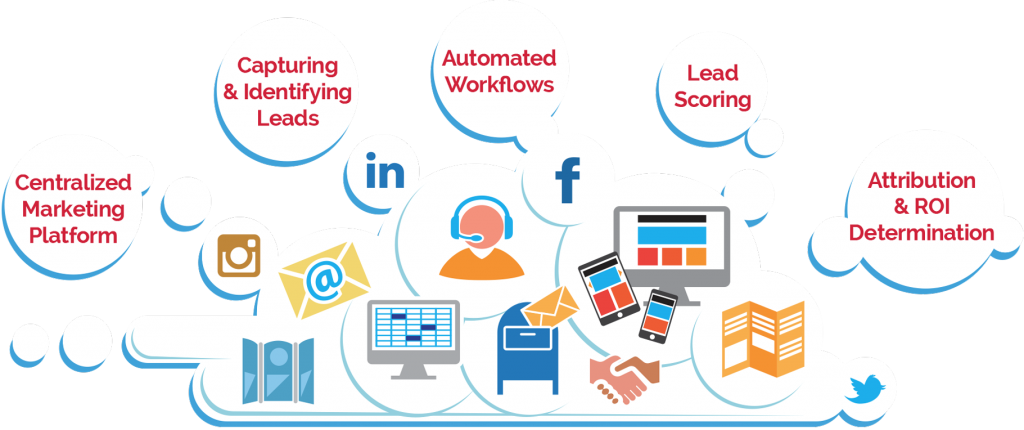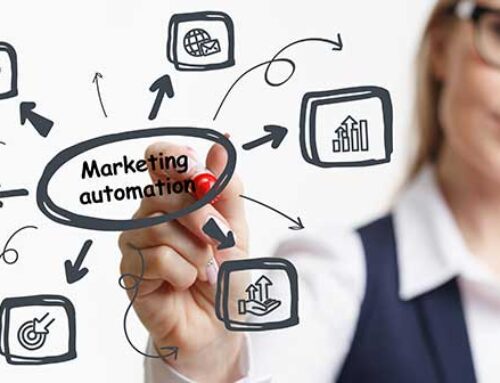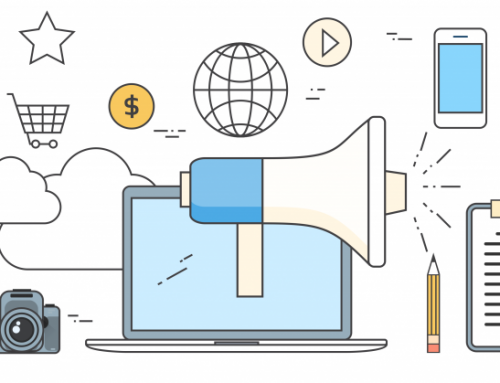Today’s top marketers use Marketing Automation to plan, launch, test and measure their marketing campaigns. They’re leveraging this huge advantage to work faster and smarter, creating and managing multichannel experiences for prospects and customers while gaining insights about preferences and behaviors.
Let’s take a quick look at the current state of Marketing Automation, and then check out where it’s headed in 2019 and beyond.
Marketing Automation Today
Marketing Automation is a set of digital tools that help marketers automatically and systematically move leads down through the marketing funnel. As they progress, prospects earn lead scores based on their demographic and firmographic attributes, and activities, then receive targeted content to nurture them from their initial attraction through to the sale.
Contemporary marketing teams implement cross-channel strategies where their website, social media, email, mobile efforts and more are tied together to engage prospects with the right offer on the right product on the right channel at the right time. When using Marketing Automation, you’ll want to use a healthy and balanced marketing approach that includes a combo of inbound and outbound campaigns:
Inbound Marketing
This approach consists of creating engaging, targeted, useful content through each stage of the customer lifecycle to attract traffic to your website while they are in-market for your products/ services and continue to establish your brand as a thought-leader in the industry. It’s a welcome alternative for buyers who prefer to visit your site on their own terms rather than being targeted with ads or email campaigns.
Outbound marketing allows you to reach out and share news, promotions and education about your brand, products, services, and solutions. In today’s highly competitive digital marketplace, outbound methods can include email, videos, webinars, on-demand training, sales calls, helpful content, and more to help you stand out from the competition.
Providers of Marketing Automation like Marketo and Pardot are constantly developing better and faster solutions to help marketers like you get the most out of their software. Here’s a peek into the near future at some trends that can help you plan to stay competitive and top this year’s numbers.
MARKETING AUTOMATION TRENDS FOR 2019
Mobile-Responsive Website Designs
Mobile technology has been incredibly disruptive to the old way of doing business. Users are now spending more than half of their time on a mobile device rather than their computers.
Next year while you’re creating a mobile-user-friendly experience with sparse layouts, minimal images, concise messaging, and simple calls-to-action, also be sure to leverage the power of geo-location by including location-based mobile strategies in the mix.
Persona-based Marketing
One size does not fit all when it comes to prospective customers. A coordinator will have very different concerns and pain points from a mid-level manager or a C-suite executive, and your campaigns must cater to those differences. Creating buyer personas gives you the ability to tailor your marketing automation efforts and connect with each different target audience to provide solutions to their specific problems.
Then use the data you collect to learn where your website visitors found your link, which keywords they used to find you, which web pages they visited and how long they stayed. These analytics will help you refine search terms and focus on the platforms and devices they’re using to find you.
Video Marketing
Customers don’t just like videos… they expect them. From vlogs to social media to website content, more and more people would rather watch a video than read. It’s a great opportunity for marketers to present stories and evoke emotions in a more compelling, engaging way.
Recent statistics shared by one video marketing firm show that video marketing will draw more than 80% of the internet traffic across the world by 2019. If you’re looking for new ways to include videos in your marketing efforts next year, consider live-streaming, vlogging, offering on-demand training modules, and highlighting key customer testimonials.
Search Marketing through SEO
Where would we be without search engines? A staggering 90% of all web activity begins with a search engine. Obviously, Google dominates this field, and they implemented some big changes this year that will deploy in 2019, the biggest of which is the launch of the “Google Marketing Platform”. This includes the renaming of “AdWords” to “Ads”, the addition of the “Doubleclick” ad platform, and a tighter integration between analysis tools like Google Analytics, Data Studio, and AB Testing.
Also watch the evolution of Google’s search snippets which will be important in understanding questions your audience is asking while using voice tech like Google Home, Amazon’s Alexa and Apple’s Siri. This will help you in tailoring your SEO strategy for voice search as you factor in what your customers might say, rather than type when asking questions.
Tell Me a Story
A couple of summers ago, Instagram Stories was born and now more than 150 million people use it daily. Facebook took notice and recently launched its own version of “Stories” featuring short user-generated photo and video collections that can be viewed twice, then disappear after 2 days. They claim the “Stories” feature will surpass Facebook’s feeds as the primary way people will share things with friends within the next year. In total, Add WhatsApp and Snapchat, and there’s a total of almost a billion people who are now using Stories to share! For brands, this social media trend requires a major shift in focus in 2019, and content teams will need to adapt accordingly.
Send Me a Message
Using “Messenger” for conversations is a major trend. Facebook reports 1.3 billion people and 78% of smartphone owners use Messenger every month. Trend-spotting marketers are now experimenting with different ways to include Messenger as another weapon in their arsenal. Some are sharing blog posts through Messenger and exploring how to engage and assist prospects and customers. Other options may include live-chatting with customers during events, and running
click-to-Messenger ads where a person clicks on an ad to learn more and is brought into a Messenger conversation with a chatbot/live person that asks a series of questions.
Buy Me a Present
You can also start incorporating social commerce into your marketing strategy by finding ways to make shopping live, interactive, and easy. Take a look at the shoppable posts on Instagram where users see something they like and buy it without ever leaving the app. They’ve even added a “Shopping” tab to the app’s Explore page. And the trend keeps growing – over half of Pinterest’s customers are using the site to find and shop for products, and check out Facebook’s Marketplace that’s being used by 800 million people globally.
Artificial Intelligence
Artificial Intelligence (AI) is still in its infancy, so figuring out how to apply it to marketing automation efforts is still pretty experimental. AI can help marketers use less guesswork and base marketing decisions on data. For example, by gathering input and analyzing data, AI can help identify online behaviors that have the highest probability of converting to customers, then find potential buyers online who exhibit those behaviors. Then, after analyzing first- and third-party data, it can help marketers optimize campaigns to improve performance.
Marketing teams can program AI to learn everything about a person and select the experience that is most appealing to that person. It can track user behavior, requirements, and needs, then make intelligent suggestions regarding the types of content your buyers are interested in during their journey through the customer lifecycle. As automated marketing technology gains intelligence and AI gets better, our tools will keep learning from experience and your campaigns will be more effective.
Chatbots
A chatbot is an AI computer program that simulates interactive human conversation via text chats. They’re often used for customer service and marketing systems connected to social networking spaces and clients who use instant messaging. We also see them as features within computer operating systems as “virtual assistants”. Chatbots can be embedded and used through any major messaging applications.
Smart chatbots are starting to play a critical lead-generation role by quickly analyzing users’ needs and requirements. Based on decision-tree-like queries and answers, a chatbot can provide information, offer discounts, and provide solutions while responding instantly and automatically. Chatbots are a very hot trend, and will likely be behind 85% of customer service interactions by 2020.
Predictive Analytics
Predictive analytics is the practice of using new and historical data to better understand customers, determine patterns and predict possible future outcomes, trends, potential risks and opportunities. It involves data mining, queries, statistical modeling and analysis, machine learning, and automated machine-learning algorithms to create predictive models that score the likelihood of particular events occurring.
Predictive analytics enable organizations to use historical and real-time data to move from a historical view to a forward-looking perspective of the customer. For example, marketers can use predictive analytics to learn when CMOs are most likely to read email, then target that persona with email campaigns designed to be sent during that window of opportunity. As predictive analytics get more accurate, marketers will gain clarity regarding which prospects to focus on from the start, and how to find buyers who will be good fits and loyal customers.
How to Get Started
We’ve shared quite a few marketing automation trends to watch in 2019, but it would be a mistake to attempt implementing them all immediately or at the same time. It is, however, the perfect time to put a solid marketing automation strategy in action. Need help? We’ve got your back:
We offer several ways for a Reach Marketing Automation Consultant to help you implement and integrate your marketing automation software:
Marketing Automation Toolkit – Maximize your investment by leveraging our Marketing Automation experts for integration, custom development, strategy, and execution
Health Check & Optimization – Assess, monitor and implement automation best practices to ensure the greatest possible return on your investment.
Campaign Execution – Full-service email campaign and workflow setup, optimization, testing, and deployment by our marketing automation experts.
Program Templates – Streamline the execution of event and email campaigns through our custom modular templates









